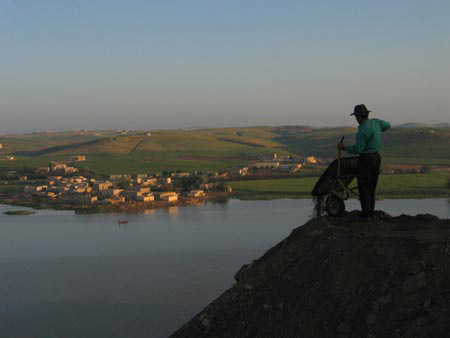Historical Background
On the border between Turkey and Syria lies the site of Karkemish, one of the most important cities of the Ancient Near East, located where the Euphrates leaves the Anatolian mountains and descends through Syria and Iraq to end in the Arabian Gulf. At Karkemish the Anatolian, the Levantine, and the Mesopotamian cultures met, and the city was a center for trade and cultural exchange for several millennia. Unfortunately the ruins are today astride the international border and not available for archaeological investigation. In recent years, however, several dam projects on the Euphrates, in Turkey and Syria, have necessitated salvage excavations at a large number of sites along the river in the hinterland of Karkemish, and thus opened up an exciting. new area of the ancient world. The Aushariye project is part of these efforts.
An interesting aspect of the project is that Aushariye with varying degrees of certainty may be identified with several localities mentioned in ancient written sources.
Tell Aushariye is located close to the confluence of the Sajour and Euphrates rivers. On the opposite, eastern bank of the Euphrates is the famous ancient city of Til Barsib (modern Tell Ahmar, currently excavated by a Belgian
expedition), which in the early Iron Age was the center for local Syrian dynasties until the Assyrian conquest in the mid-9th cent. BC, when it became a provincial capital in the Assyrian empire. The Assyrian king Shalmaneser III reports in his annals how he conquered Til Barsib, crossed the Euphrates and received tribute from local princes in a place on the Sajour which the locals called Pitru, but also had an Assyrian name, Ana-Assur-uter-asbat (“I reconquered for the (god) Assur”). This shows that the place had been in Assyrian hands before, and Shalmaneser notes that his predecessor, Tiglathpileser I had established an Assyrian garrison there ca. 1100 BC.
Aushariye is thus located precisely where ancient Pitru should be, and since there are no other similar sites nearby, it is a reasonable assumption that Aushariye hides the ruins of ancient Pitru. The excavations have not yet furnished any proof of this theory, but it is supported by the find of a stela with an Assyrian inscription, authored by exactly Shalmaneser III.
Pitru is also known from Egyptian sources from the Late Bronze Age, and is traditionally identified with the Biblical Pethor, home town of the famous Balaam, especially known from the tale of his “talking donkey” in The Old Testament (Numeri Chap. 22).
Finally there is the possibility that Aushariye may be identified with a fortress from the Middle Bronze Age (ca. 1800 BC), known as Dur-Sumu-Epuh, and which guarded the border between the two main powers in northern Syria and Mesopotamia.

Excavation in Area G.

View from west slope of Aushariye.
Fragment of stela

Fragment of stela of Shalmaneser III
More Information »
